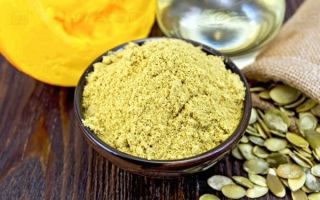Content
- 1 Chemical composition and calorie content of pumpkin flour
- 2 Useful and medicinal properties of pumpkin flour
- 3 The benefits of pumpkin meal for weight loss
- 4 How to take pumpkin seed flour for medicinal purposes
- 5 The use of pumpkin flour in cosmetology
- 6 What can be made from pumpkin flour
- 7 How to make pumpkin flour at home
- 8 Which is healthier: pumpkin or wheat flour
- 9 Harm of pumpkin flour and contraindications
- 10 How to store pumpkin flour
- 11 Conclusion
The beloved vegetable, pumpkin, appeared in Mexico, where it was grown for a long time for the sake of valuable and healthy seeds. Over time, its benefits were understood not only at home, but throughout the world. Oil was extracted from pumpkin seeds, and the residues after pressing were dried and ground into powder, from which fragrant bread was baked. Today, no less is said about the beneficial medicinal properties of the product. The benefits and harms of pumpkin flour are widely discussed by nutritionists, cosmetologists, doctors and deserve special attention.
Chemical composition and calorie content of pumpkin flour
The grind, obtained from pumpkin seeds, is greenish-yellow in color, has a pleasant aroma. The popularity and benefits are due to the content of valuable substances with unique properties:
- a set of vitamins: C, A, K, B3 and B9 (folic acid);
- important minerals: K (potassium), Mn (manganese), Mg (magnesium), P (phosphorus), Fe (iron), Ca (calcium), Cu (copper), Se (selenium) and Zn (zinc);
- valuable omega-3 fatty acids (alpha linolenic acid / ALA);
- bioflavonoids, amino acids (about fifty).
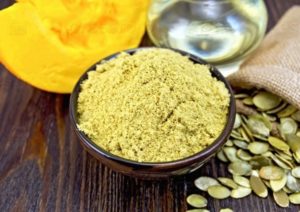
Caloric content is relatively low: 100 g contains about 305 kcal.
Useful and medicinal properties of pumpkin flour
This effective remedy has a beneficial effect on many ailments:
- diseases of the genitourinary system, kidneys;
- impaired reproductive function in men;
- deviations in the work of the liver, digestive organs;
- weakening of the immune system;
- decrease in metabolism and slowdown of metabolism;
- treatment of helminthiases (pumpkin flour is effective against parasites);
- disease of the century - diabetes mellitus;
- different types of anemia;
- malfunctions of the heart and blood vessels;
- problem skin and poor wound healing;
- a tendency to depression.
The benefits of pumpkin meal for weight loss
The secret of the benefits of pumpkin seed meal for weight loss is in a valuable property: it speeds up metabolism, which promotes a rapid metabolism, reducing fat deposition and the accumulation of fluid in the subcutaneous fatty tissue. To get rid of extra pounds, it is enough to use sauces, soups or cocktails.
A three-week meal of a flour shake as breakfast for weight loss:
- First week: dilute 1.5 teaspoons of flour in 100 g of kefir, yogurt or milk.
- Second week: stir 3 teaspoons of flour in 100 g of kefir, yogurt, milk.
- Third week: Dissolve 4 teaspoons of flour in 150 g of kefir / yogurt / milk.
Take enough once in the morning.
These breakfasts are ideal for people who are struggling with excess weight, in addition, they will rid the body of toxins and toxins.
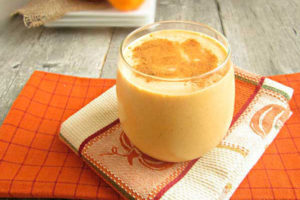
How to take pumpkin seed flour for medicinal purposes
The indisputable benefit of pumpkin seed flour is that it is combined with all dishes and any medication. The natural protein-vitamin-mineral complex is useful in the treatment of any diseases, as it reduces the load on the liver.
For the prevention and treatment of the above diseases, 1-2 tsp is enough. stir in 100 g of milk / kefir / yogurt / juice and drink 2 p. per day for 30 days. Reception for such therapeutic and prophylactic purposes is recommended 3-4 times a year.
The use of pumpkin flour in cosmetology
The benefits of pumpkin flour for women are doubled with the use of its valuable properties in cosmetology. Due to its influence (high content of amino acids) collagen is synthesized in the skin naturally, which allows it to be in the composition of anti-aging agents. The high zinc content regulates the secretion of the sebaceous glands, preventing inflammation and acne.
To prepare a toning and rejuvenating mask, mix flour and water until a thick homogeneous mixture is obtained. Apply the mask to the face, leave to dry completely, rinse with warm water, then apply any nourishing cream.

What can be made from pumpkin flour
A useful product (daily rate - 1 tbsp. L.) It is good to add to ready-made dishes as thickeners:
- all sauces for dressing vegetable, meat and fish dishes;
- any soups;
- all kinds of cereals;
- various drinks.
When baking, flour is mixed with wheat (1-2 tbsp. L. Per 1 kg of wheat flour).
Pancakes, pancakes, donuts, muffins will be lush and fragrant. The baked goods stay fresh longer.
When frying meat, vegetable and fish dishes, a healthy product is used for breading.
How to make pumpkin flour at home
The flour made at home will turn out to be natural, without unwanted additives. The first step is to buy a pumpkin from a market or supermarket.
From pumpkin seeds
Seed preparation:
- Remove seeds from the fruit, wash, dry in air (if not possible, in the oven or in a pan).
- Grind in a blender.
- Repeat grinding if necessary after touching.
- Sift the grind, separate the flour from the bran, pour into a dry jar.
- Grind the bran again.
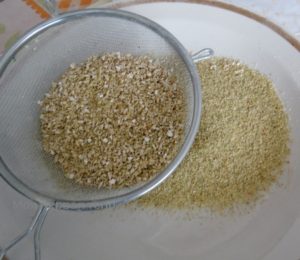
From pumpkin pulp
It is also possible to make flour from the pulp, but it will not have such a high content of essential and useful fatty acids. The advantage of such a product is the large amount of carotenoids that have powerful antioxidant properties.
Preparation from pulp:
- Peel a ripe vegetable, remove the seeds.
- Chop the pulp and dry it in a household dryer or oven until completely dry.
- Grind dry in a blender or food processor.
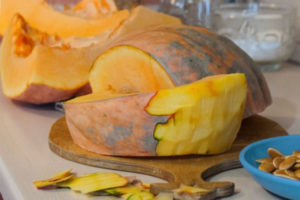
Using this beneficial grind in cooking is similar to using seed flour.
Which is healthier: pumpkin or wheat flour
Both types differ in composition and, accordingly, properties. The calorie content of wheat is higher: 342 kcal. Its benefits are in more fats, proteins and carbohydrates. For an ideal ratio of nutrients, a mixture of two types is used. However, wheat contains a protein called gluten. Pumpkin is gluten-free and ideal for people who are intolerant to wheat protein.
Harm of pumpkin flour and contraindications
Harm is possible from excessive consumption, which can cause indigestion:
- increased gas formation;
- diarrhea;
- constipation.
Harm can also be due to individual intolerance to the product.
How to store pumpkin flour
In order to preserve the benefits of the properties of flour, store it in a dark place.Protect from high humidity at room temperature (no higher than 25 ° C). It is convenient to buy in hermetically sealed packaging. If the product was purchased in a paper or cellophane bag, it is better to pour it into a jar with a tight lid.
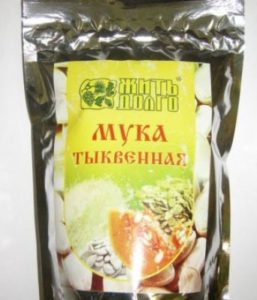
Conclusion
The benefits and harms of pumpkin flour, the regular intake of which stabilizes metabolic processes, improves the functioning of internal organs, are well known to all supporters of healthy nutrition. You should not take too much of it: it will not be beneficial. To avoid harm, you need to listen to yourself and observe the reaction. If you feel worse, the intake of the product should be limited or stopped. Competent addition to the diet will exclude harm from use, ensure health and good mood.
Video about the benefits and dangers of pumpkin flour:

